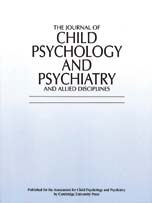Crossref Citations
This article has been cited by the following publications. This list is generated based on data provided by
Crossref.
Vostanis, P.
Tischler, V.
Cumella, S.
and
Bellerby, T.
2001.
Mental Health Problems and Social Supports Among Homeless Mothers and Children Victims of Domestic and Community Violence.
International Journal of Social Psychiatry,
Vol. 47,
Issue. 4,
p.
30.
Earls, Felton
2001.
Community Factors Supporting Child Mental Health.
Child and Adolescent Psychiatric Clinics of North America,
Vol. 10,
Issue. 4,
p.
693.
Mohler, Beat
2001.
Cross-cultural Issues in Research On Child Mental Health.
Child and Adolescent Psychiatric Clinics of North America,
Vol. 10,
Issue. 4,
p.
763.
2004.
National Institute of Mental Health Multimodal Treatment Study of ADHD Follow-up: 24-Month Outcomes of Treatment Strategies for Attention-Deficit/Hyperactivity Disorder.
Pediatrics,
Vol. 113,
Issue. 4,
p.
754.
2004.
National Institute of Mental Health Multimodal Treatment Study of ADHD Follow-up: Changes in Effectiveness and Growth After the End of Treatment.
Pediatrics,
Vol. 113,
Issue. 4,
p.
762.
Horton, Nicholas J.
and
Fitzmaurice, Garrett M.
2004.
Regression analysis of multiple source and multiple informant data from complex survey samples.
Statistics in Medicine,
Vol. 23,
Issue. 18,
p.
2911.
Drukker, Marjan
Buka, Stephen L.
Kaplan, Charles
McKenzie, Kwame
and
Van Os, Jim
2005.
Social capital and young adolescents’ perceived health in different sociocultural settings.
Social Science & Medicine,
Vol. 61,
Issue. 1,
p.
185.
Kirk, David S.
2006.
Examining the Divergence Across Self-report and Official Data Sources on Inferences About the Adolescent Life-course of Crime.
Journal of Quantitative Criminology,
Vol. 22,
Issue. 2,
p.
107.
Flannery, Daniel J.
Singer, Mark I.
van Dulmen, Manfred
Kretschmar, Jeff M.
and
Belliston, Lara M.
2007.
The Cambridge Handbook of Violent Behavior and Aggression.
p.
306.
Litman, Heather J.
Horton, Nicholas J.
Hernández, Bernardo
and
Laird, Nan M.
2007.
Epidemiology and Medical Statistics.
Vol. 27,
Issue. ,
p.
730.
Suglia, Shakira Franco
Ryan, Louise
Laden, Francine
Dockery, Douglas W.
and
Wright, Rosalind J.
2008.
Violence Exposure, A Chronic Psychosocial Stressor, and Childhood Lung Function.
Psychosomatic Medicine,
Vol. 70,
Issue. 2,
p.
160.
Foster, Holly
and
Brooks-Gunn, Jeanne
2009.
Toward a Stress Process Model of Children’s Exposure to Physical Family and Community Violence.
Clinical Child and Family Psychology Review,
Vol. 12,
Issue. 2,
p.
71.
Gibson, Chris L.
Morris, Sara Z.
and
Beaver, Kevin M.
2009.
Secondary Exposure to Violence During Childhood and Adolescence: Does Neighborhood Context Matter?.
Justice Quarterly,
Vol. 26,
Issue. 1,
p.
30.
Gardner, Margo
and
Brooks‐Gunn, Jeanne
2009.
Adolescents' exposure to community violence: are neighborhood youth organizations protective?.
Journal of Community Psychology,
Vol. 37,
Issue. 4,
p.
505.
Jenkins, Esther J.
Wang, Edward
and
Turner, Larry
2009.
Traumatic events involving friends and family members in a sample of African American early adolescents..
American Journal of Orthopsychiatry,
Vol. 79,
Issue. 3,
p.
398.
Paquette Boots, Denise
and
Wareham, Jennifer
2009.
An Exploration of DSM-Oriented Scales in the Prediction of Criminal Offending Among Urban American Youths.
Criminal Justice and Behavior,
Vol. 36,
Issue. 8,
p.
840.
Goodman, Kimberly L.
De Los Reyes, Andres
and
Bradshaw, Catherine P.
2010.
Understanding and Using Informants’ Reporting Discrepancies of Youth Victimization: A Conceptual Model and Recommendations for Research.
Clinical Child and Family Psychology Review,
Vol. 13,
Issue. 4,
p.
366.
Suglia, Shakira Franco
Staudenmayer, John
Cohen, Sheldon
and
Wright, Rosalind J.
2010.
Posttraumatic Stress Symptoms Related to Community Violence and Children’s Diurnal Cortisol Response in an Urban Community-Dwelling Sample.
International Journal of Behavioral Medicine,
Vol. 17,
Issue. 1,
p.
43.
Lewis, Terri
Kotch, Jonathan
Thompson, Richard
Litrownik, Alan J.
English, Diana J.
Proctor, Laura J.
Runyan, Desmond K.
and
Dubowitz, Howard
2010.
Witnessed violence and youth behavior problems: A multi‐informant study..
American Journal of Orthopsychiatry,
Vol. 80,
Issue. 4,
p.
443.
Javaras, Kristin N.
Goldsmith, H. Hill
and
Laird, Nan M.
2011.
Estimating the Effect of a Predictor Measured by Two Informants on a Continuous Outcome.
Epidemiology,
Vol. 22,
Issue. 3,
p.
390.


